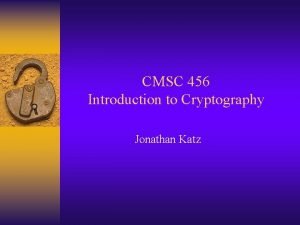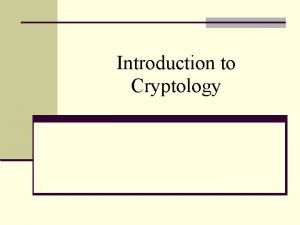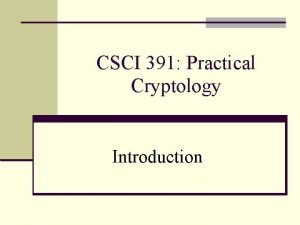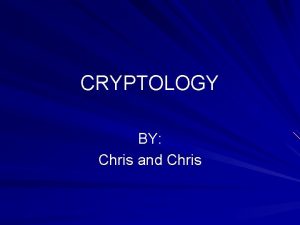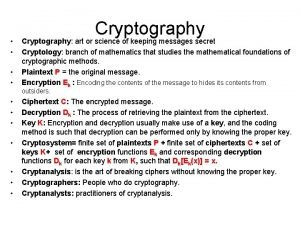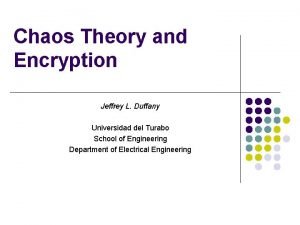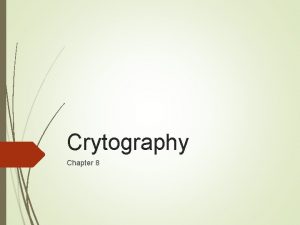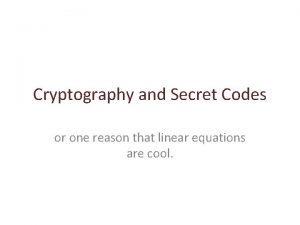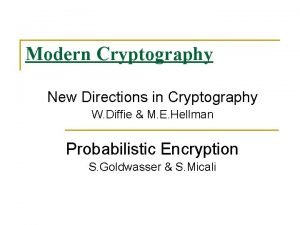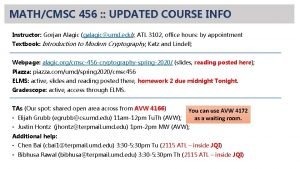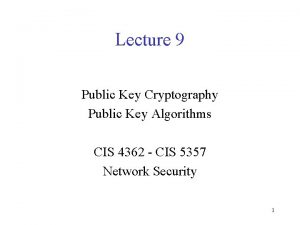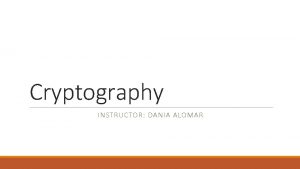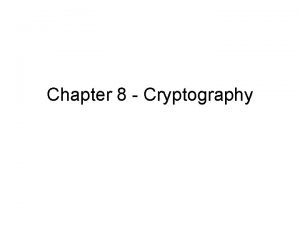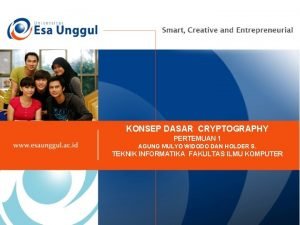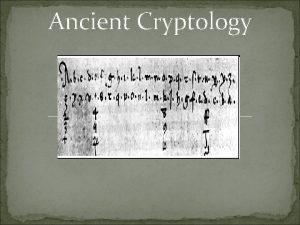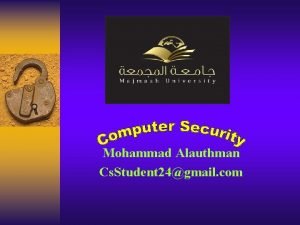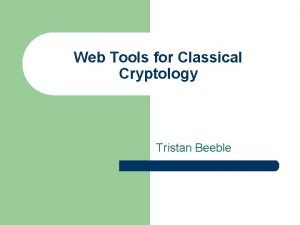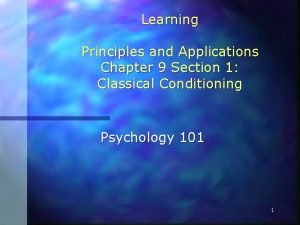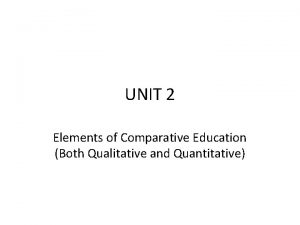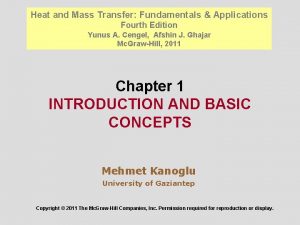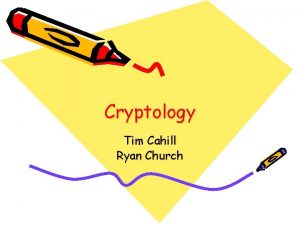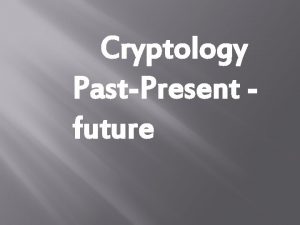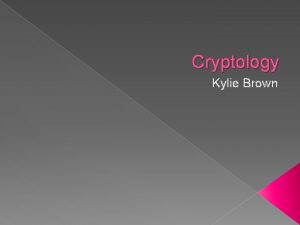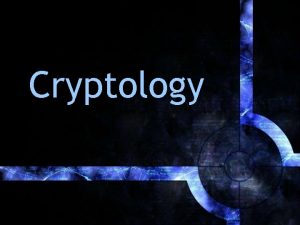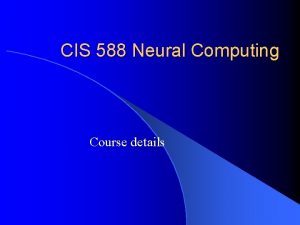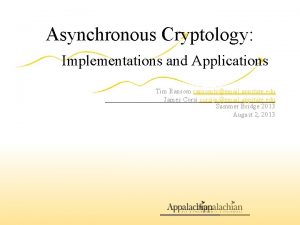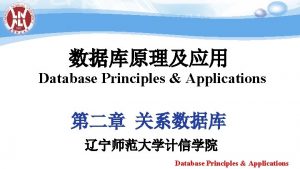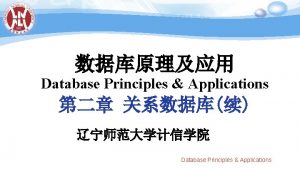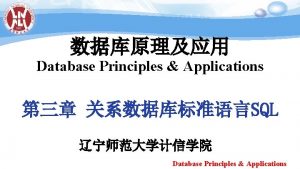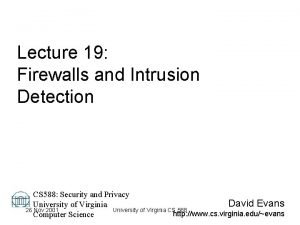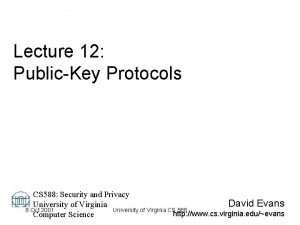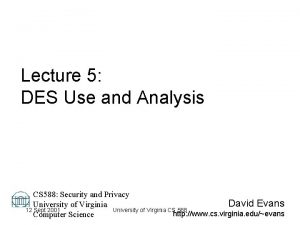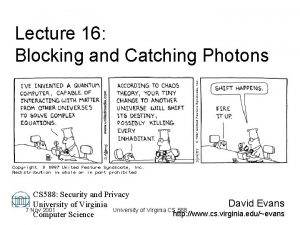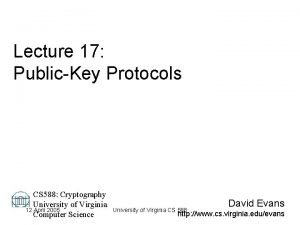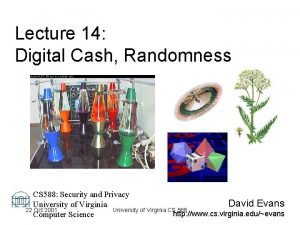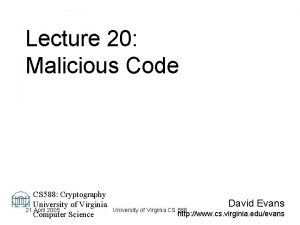CS 588 Cryptology Principles and Applications Lecture 1


















![Substitution Cipher • C = EK(p) Ci = K[pi] • Key is alphabet mapping: Substitution Cipher • C = EK(p) Ci = K[pi] • Key is alphabet mapping:](https://slidetodoc.com/presentation_image/92dbda7f053822cf1f3a3b9a34fc29b1/image-19.jpg)
















![Perfectly Secure Cipher: One-Time Pad • Mauborgne/Vernam [1917] • XOR ( ): 0 0=0 Perfectly Secure Cipher: One-Time Pad • Mauborgne/Vernam [1917] • XOR ( ): 0 0=0](https://slidetodoc.com/presentation_image/92dbda7f053822cf1f3a3b9a34fc29b1/image-36.jpg)





- Slides: 41

CS 588: Cryptology – Principles and Applications Lecture 1: Introduction With a magnetic card and his dog Buddy's name as a password, President Clinton e-signed a bill Friday that will make electronic signatures as real as those on paper. Fox. News, 30 June 2000 CS 588: Cryptology University of Virginia 29 Aug 2001 Computer Science University of Virginia CS 588 David Evans http: //www. cs. virginia. edu/~evans

Menu • Course Introduction – Why you should or shouldn’t take this course – Course Logistics: details on Syllabus • Introduction to Cryptology – Terminology – A simple substitution cipher – Brief history of 4000 years of Cryptology Send registration email by noon Friday. 29 Aug 2001 University of Virginia CS 588 2

Resources • David Evans (call me “Dave”), devans@virginia. edu Office Hours (236 A): Tuesdays, 10: 30 -11: 30 am; Weds after class Research: code safety, static analysis, programming and reasoning about swarms • TAs: Danny Loffredo, dgl 4 b@virginia. edu CS Reading Room: Tuesdays, 3: 30 -4: 30 Anthony Wood, adw 5 p@virginia. edu TBA • Web: http: //www. cs. virginia. edu/cs 588 29 Aug 2001 University of Virginia CS 588 3

Why you should take this course? Reason #1: Fate of Humanity Cryptology plays a central role in human history. More than anything else, survival of humanity depends on computer security. 29 Aug 2001 University of Virginia CS 588 4

Why you should take this course? Reason #2: Intellectual Cryptology is about making and solving puzzles. Purest form of intellectual endeavor. 29 Aug 2001 University of Virginia CS 588 5

Why you should take this course? Reason #3: Be like Tom Mr. Jefferson would have wanted you to. 29 Aug 2001 University of Virginia CS 588 6

Bad reasons to take this class • You want to write the ultimate destructive virus. • You want to break into (UVA’s | the CIA’s | your bank’s) computer systems. 29 Aug 2001 University of Virginia CS 588 7

How to get an A in CS 551 Problem Sets (40 -50%) 4 throughout term (1 st is due 10 Sept) Project (30 -50%) Teams of 1 – 4 Can involve design/implementation Can involve survey/analysis Exams (30 -50%) Midterm, Final Class Contribution (0 -10%) 29 Aug 2001 University of Virginia CS 588 8

“Easy ways” to get an A in CS 551 • Break into my grades file (on my home computer) and change your grade to “Haha” – Physical attacks on my house, car or office are NOT eligible! (And NOT encouraged!) – Don’t try to break into UVA’s grade records: • Too easy (probably only worth a B, or C- for social engineering attack) • Honor code violation • Discover a security flaw important enough to get reported in the New York Times • Factor RSA-300 = 2769315567803442139028689061647233092237608363983953254005036722809375824714 9473946190060218756255124317186573105075074546238828817121274630072161346956 4396741836389979086904304472476001839015983033451909174663464663867829125664 459895575157178816900228792711267471958357574416714366499722090015674047 29 Aug 2001 University of Virginia CS 588 9

Bonus Points / Demerits (100 points = 1 problem set) +100 Posting in RISKS +(varies) Solving a challenge problem -100 -200 -100000 29 Aug 2001 Send me a virus Get arrested for computer attack Get convicted for computer attack I get arrested for something you do University of Virginia CS 588 10

Challenge Problems • Open until solved or last day of class • Usually only first satisfactory answer gets bonus – Better, later answer might still get bonus • Solve in groups, each member gets n / n * value (e. g. , 2 people = 2 / 2 = 0. 7) First challenge problem starts tomorrow: Jefferson wheel cryptogram (see course web page) 29 Aug 2001 University of Virginia CS 588 11

Decrypting the Honor Code • Learn from your fellow students – they are your best resource! • Write down who you discussed assignments with, all external sources you used • Don’t use answers from last year’s class • Be honest – you know what cheating is and isn’t • Don’t “pledge” your assignments, but let me know if you plan to cheat 29 Aug 2001 University of Virginia CS 588 12

Logistics Questions? 29 Aug 2001 University of Virginia CS 588 13

What is cryptology? • Greek: “krypto” = hide • Cryptology – science of hiding = cryptography + cryptanalysis + steganography • Cryptography – secret writing • Cryptanalysis – analyzing (breaking) secrets Cryptanalysis is what attacker does Decipher or Decryption is what legitimate receiver does • Kryptonite – breaking ciphers all night? 29 Aug 2001 University of Virginia CS 588 14

Cryptology and Security Cryptology is a branch of mathematics. Security is about people. 29 Aug 2001 University of Virginia CS 588 15

Terminology Insecure Channel Plaintext Alice 29 Aug 2001 Encrypt Ciphertext Decrypt Eve C = E(P) P = D(C) E must be invertible University of Virginia CS 588 Plaintext Bob 16

Kerckhoff’s Principle • Cryptography always involves: – Transformation – Secret • Security should depend only on the key • Don’t assume enemy won’t know algorithm – Can capture machines, disassemble programs, etc. – Too expensive to invent new algorithm if it might have been compromised • Security through obscurity isn’t – Look at history of examples – Better to have scrutiny by open experts 29 Aug 2001 “The enemy knows the system being used. ” Claude Shannon University of Virginia CS 588 17

Alice and Bob Plaintext Encrypt Ciphertext Decrypt KE Alice 29 Aug 2001 Plaintext KD Bob C = E(KE, P) = EKE (P) P = D(KD, C) = DKD (C) If KE = KD it is symmetric encryption If KE KD it is asymmetric encryption University of Virginia CS 588 18
![Substitution Cipher C EKp Ci Kpi Key is alphabet mapping Substitution Cipher • C = EK(p) Ci = K[pi] • Key is alphabet mapping:](https://slidetodoc.com/presentation_image/92dbda7f053822cf1f3a3b9a34fc29b1/image-19.jpg)
Substitution Cipher • C = EK(p) Ci = K[pi] • Key is alphabet mapping: a J, b L, . . . • Suppose attacker knows algorithm but not key, how many keys to try? 26! If every person on earth tried one per second, it would take 5 B years. 29 Aug 2001 University of Virginia CS 588 19

Monoalphabetic Cipher “XBW HGQW XS ACFPSUWG FWPGWXF CF AWWKZV CDQGJCDWA CD BHYJD DJXHGW; WUWD XBW ZWJFX PHGCSHF YCDA CF GSHFWA LV XBW KGSYCFW SI FBJGCDQ RDSOZWAQW OCXBBWZA IGSY SXBWGF. ” 29 Aug 2001 University of Virginia CS 588 20

Frequency Analysis “XBW HGQW XS ACFPSUWG FWPGWXF CF AWWKZV CDQGJCDWA CD BHYJD DJXHGW; WUWD XBW ZWJFX PHGCSHF YCDA CF GSHFWA LV XBW KGSYCFW SI FBJGCDQ RDSOZWAQW OCXBBWZA IGSY SXBWGF. ” W: 20 C: 11 F: 11 G: 11 29 Aug 2001 “Normal” English: e 12% t 9% a 8% University of Virginia CS 588 21

Pattern Analysis “XBe HGQe XS ACFPSUe. G Fe. PGe. XF CF Aee. KZV CDQGJCDe. A CD BHYJD DJXHGe; e. Ue. D XBe Ze. JFX PHGCSHF YCDA CF GSHFe. A LV XBe KGSYCFe SI FBJGCDQ RDSOZe. AQe OCXBBe. ZA IGSY SXBe. GF. ” XBe = “the” Most common trigrams in English: the = 6. 4% and = 3. 4% 29 Aug 2001 University of Virginia CS 588 22

Guessing “the HGQe t. S ACFPSUe. G Fe. PGet. F CF Aee. KZV CDQGJCDe. A CD h. HYJD DJt. HGe; e. Ue. D the Ze. JFt PHGCSHF YCDA CF GSHFe. A LV the KGSYCFe SI Fh. JGCDQ RDSOZe. AQe OCthhe. ZA IGSY Sthe. GF. ” S = “o” 29 Aug 2001 University of Virginia CS 588 23

Guessing “the HGQe to ACFPo. Ue. G Fe. PGet. F CF Aee. KZV CDQGJCDe. A CD h. HYJD DJt. HGe; e. Ue. D the Ze. JFt PHGCo. HF YCDA CF Go. HFe. A LV the KGo. YCFe o. I Fh. JGCDQ RDo. OZe. AQe OCthhe. ZA IGo. Y othe. GF. ” othe. GF = “others” 29 Aug 2001 University of Virginia CS 588 24

Guessing “the Hr. Qe to ACs. Po. Uer se. Prets Cs Aee. KZV CDQr. JCDe. A CD h. HYJD DJt. Hre; e. Ue. D the Ze. Jst PHr. Co. Hs YCDA Cs ro. Hse. A LV the Kro. YCse o. I sh. Jr. CDQ RDo. OZe. AQe OCthhe. ZA Iro. Y others. ” “se. Prets” = “secrets” 29 Aug 2001 University of Virginia CS 588 25

Guessing “the Hr. Qe to ACsco. Uer secrets Cs Aee. KZV CDQr. JCDe. A CD h. HYJD DJt. Hre; e. Ue. D the Ze. Jst c. Hr. Co. Hs YCDA Cs ro. Hse. A LV the Kro. YCse o. I sh. Jr. CDQ RDo. OZe. AQe OCthhe. ZA Iro. Y others. ” “ACsco. Uer” = “discover” 29 Aug 2001 University of Virginia CS 588 26

Guessing “the Hr. Qe to discover secrets is dee. KZV i. DQr. Ji. Ded i. D h. HYJD DJt. Hre; eve. D the Ze. Jst c. Hrio. Hs Yi. Dd is ro. Hsed LV the Kro. Yise o. I sh. Jri. DQ RDo. OZed. Qe Oithhe. Zd Iro. Y others. ” 29 Aug 2001 University of Virginia CS 588 27

Monoalphabetic Cipher “The urge to discover secrets is deeply ingrained in human nature; even the least curious mind is roused by the promise of sharing knowledge withheld from others. ” - John Chadwick, The Decipherment of Linear B 29 Aug 2001 University of Virginia CS 588 28

Why was it so easy? • Doesn’t hide statistical properties of plaintext • Doesn’t hide relationships in plaintext (EE cannot match dg) • English (and all natural languages) are very redundant: about 1. 3 bits of information per letter – Compress English with gzip – about 1: 6 29 Aug 2001 University of Virginia CS 588 29

How to make it harder? • Cosmetic • Hide statistical properties: – Encrypt “e” with 12 different symbols, “t” with 9 different symbols, etc. – Add nulls, remove spaces • Polyalphbetic cipher – Use different substitutions • Transposition – Scramble order of letters 29 Aug 2001 University of Virginia CS 588 30

Types of Attacks • Ciphertext-only - How much Ciphertext? • Known Plaintext - often “Guessed Plaintext” • Chosen Plaintext (get ciphertext) – Not as uncommon as it sounds! • • Chosen Ciphertext (get plaintext) Not recommended in CS 588 Dumpster Diving Social Engineering “Rubber-hose cryptanalysis” – Cryptanalyst uses threats, blackmail, torture, bribery to get the key. 29 Aug 2001 University of Virginia CS 588 31

Really Brief History First 4000 years Vigenère Babbage breaks Vigenère; Kasiski (1863) publishes Cryptographers Alberti – first polyalphabetic cipher monoalphabetics Cryptanalysts 3000 BC 29 Aug 2001 al-Kindi - frequency analysis 900 1460 University of Virginia CS 588 1854 32

Really Brief History - last 100 years Mauborgne – one-time pad Quantum Crypto ? Linear, Differential Cryptanalysis Feistel block cipher, DES Enigma adds rotors, stops repeated key Turing’s loop attacks, Colossus Public-Key 1978 Rejewski repeated message-key attack Cryptanalysts Mechanical ciphers - Enigma Cryptographers 1854 1918 1939 1945 1973 1895 – Invention of Radio 29 Aug 2001 University of Virginia CS 588 33

Themes • Arms race between cryptographers and cryptanalysts – But, often disconnect between two (e. g. , Mary Queen of Scots uses monoalphabetic cipher long after known breakable) • Motivated by war (more recently: commerce) • Driven by advances in technology, mathematics • Multi-disciplinary field – Linguists, classicists, mathematicians, computer scientists, physicists • Secrecy often means advances rediscovered and miscredited 29 Aug 2001 University of Virginia CS 588 34

Security vs. Pragmatics • Trade-off between security and effort – one-time pad: perfect security, but requires distribution and secrecy of long key – DES: short key, fast algorithm, but breakable – quantum cryptography: perfect security, guaranteed secrecy of key, slow, requires expensive hardware • Don’t spend $10 M to protect $1 M. • Don’t protect $1 B with encryption that can be broken for $1 M. 29 Aug 2001 University of Virginia CS 588 35
![Perfectly Secure Cipher OneTime Pad MauborgneVernam 1917 XOR 0 00 Perfectly Secure Cipher: One-Time Pad • Mauborgne/Vernam [1917] • XOR ( ): 0 0=0](https://slidetodoc.com/presentation_image/92dbda7f053822cf1f3a3b9a34fc29b1/image-36.jpg)
Perfectly Secure Cipher: One-Time Pad • Mauborgne/Vernam [1917] • XOR ( ): 0 0=0 1 0=1 0 1=1 1 1=0 a a=0 a 0=a a b b=a • E(P, K) = P K D(C, K) = C K = (P K) K = P 29 Aug 2001 University of Virginia CS 588 36

Why perfectly secure? • For any given ciphertext, all plaintexts are equally possible. Ciphertext: 0100111110101 Key 1: 1100000100110 Plaintext 1: 1000111010011 = “CS” Key 2: 1100010100110 Plaintext 2: 1000101010011 = “BS” • More formal proof next time 29 Aug 2001 University of Virginia CS 588 37

Go to the beach? • Cannot reuse K – What if receiver has C 1 = P 1 K and C 2 = P 2 K C 1 C 2 = P 1 K P 2 K = P 1 P 2 • Need to generate truly random bit sequence as long as all messages • Need to securely distribute key 29 Aug 2001 University of Virginia CS 588 38

“One-Time” Pad’s in Practice • Lorenz Machine – Nazi high command in WWII – Pad generated by 12 rotors – Receiver and sender set up rotors in same positions – One operator retransmitted a message (but abbreviated message header the second time!) – Enough for Bletchley Park to figure out key – and structure of machine that generated it! – But still had to try all configurations 29 Aug 2001 University of Virginia CS 588 39

Colossus – First Programmable Computer • Bletchley Park, 1944 • Read ciphertext and Lorenz wheel patterns from tapes • Tried each alignment, calculated correlation with German • Decoded messages (63 M letters by 10 Colossus machines) that enabled Allies to know German troop locations to plan D-Day • Destroyed in 1960, kept secret until 1970 s 29 Aug 2001 University of Virginia CS 588 40

Charge • Send me your registration survey by noon tomorrow • Start thinking about projects and teams • Subscribe to comp. risks and Cryptogram (instructions on manifest) • Next time: – Proving Ciphers are Perfect (in Theory) – Information Theory 29 Aug 2001 University of Virginia CS 588 41
 Cmsc 456 3 cryptology
Cmsc 456 3 cryptology Cs 588
Cs 588 Zvi wiener
Zvi wiener 02 588
02 588 Investments bkm
Investments bkm Introduction to cryptology
Introduction to cryptology Security and cryptology
Security and cryptology Cryptology and pathology
Cryptology and pathology Chris concepts
Chris concepts It is the art of keeping messages secure.
It is the art of keeping messages secure. Chaos theory and cryptology
Chaos theory and cryptology 01:640:244 lecture notes - lecture 15: plat, idah, farad
01:640:244 lecture notes - lecture 15: plat, idah, farad Cryptology chapter 8 ccccure
Cryptology chapter 8 ccccure Cryptology codes
Cryptology codes Cryptography means
Cryptography means 1976 new directions in cryptology
1976 new directions in cryptology Cmsc 456 3 cryptology
Cmsc 456 3 cryptology Cis 4362 introduction to cryptology
Cis 4362 introduction to cryptology Cryptology cryptography cryptanalysis
Cryptology cryptography cryptanalysis Cryptology chapter 8 ccccure
Cryptology chapter 8 ccccure Apa hubungannya cryptanalysis dengan cryptology?
Apa hubungannya cryptanalysis dengan cryptology? Ancient cryptology
Ancient cryptology 24gmail
24gmail Cryptology tools
Cryptology tools Terahertz spectroscopy principles and applications
Terahertz spectroscopy principles and applications Sport management principles and applications
Sport management principles and applications Principles and applications of electrical engineering
Principles and applications of electrical engineering Principles and applications of electrical engineering
Principles and applications of electrical engineering Learning principles and applications
Learning principles and applications Principles of economics powerpoint lecture slides
Principles of economics powerpoint lecture slides Comparative education definition
Comparative education definition Principles of network applications
Principles of network applications Principles of network applications
Principles of network applications Heat and mass transfer fundamentals and applications
Heat and mass transfer fundamentals and applications Image sets
Image sets Electricity and magnetism lecture notes
Electricity and magnetism lecture notes Power system dynamics and stability lecture notes
Power system dynamics and stability lecture notes Microbial physiology lecture notes
Microbial physiology lecture notes Limits fits and tolerances
Limits fits and tolerances Parallel and distributed computing lecture notes
Parallel and distributed computing lecture notes Fundamental deviation
Fundamental deviation Financial institutions and markets lecture notes ppt
Financial institutions and markets lecture notes ppt
